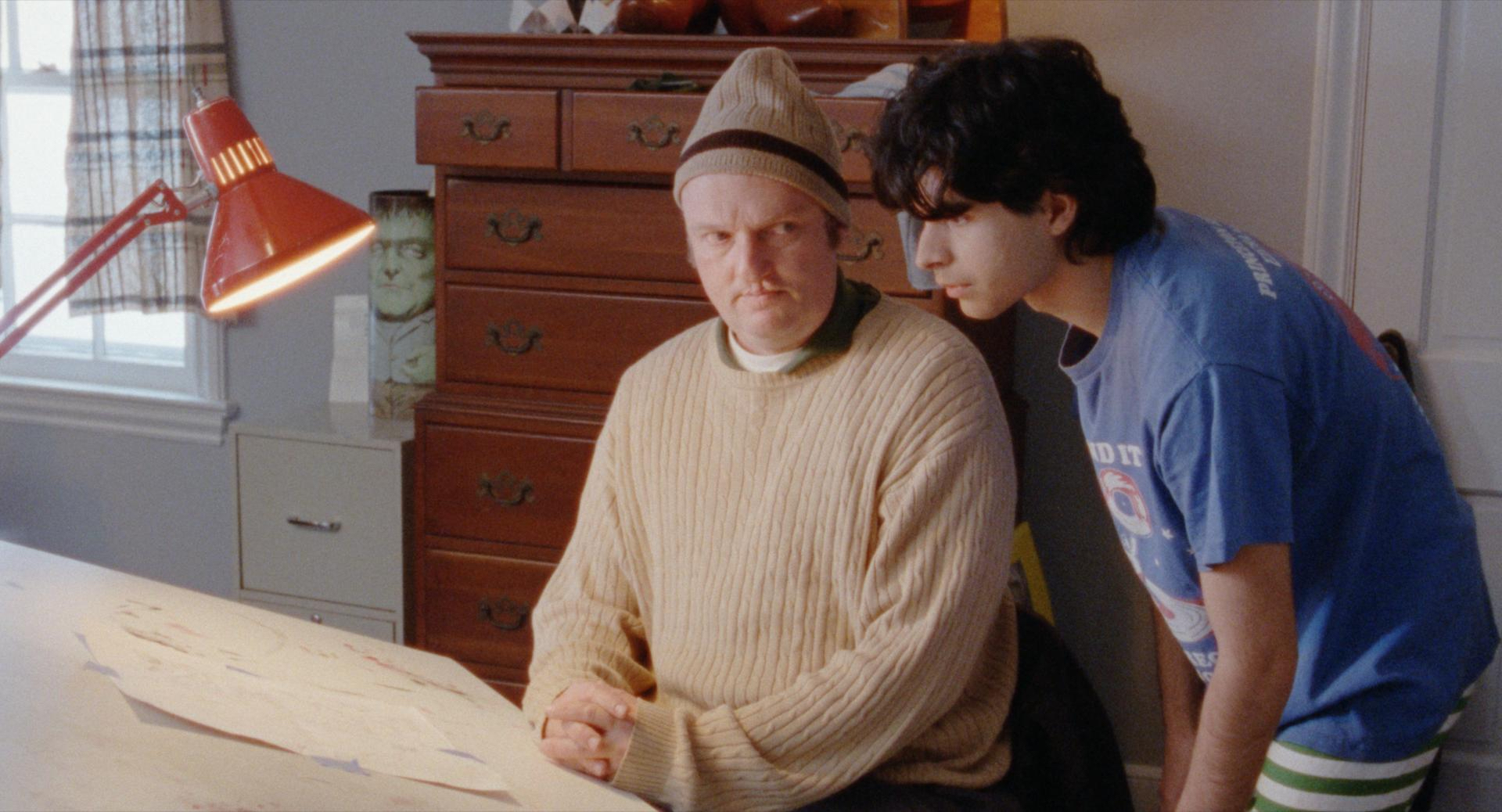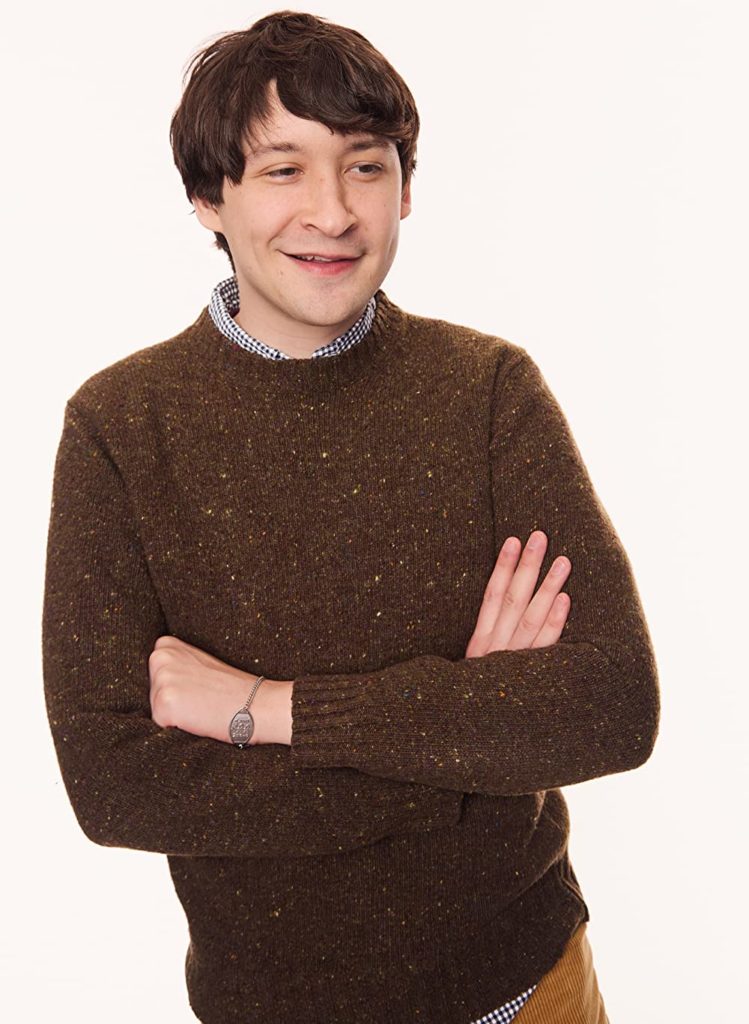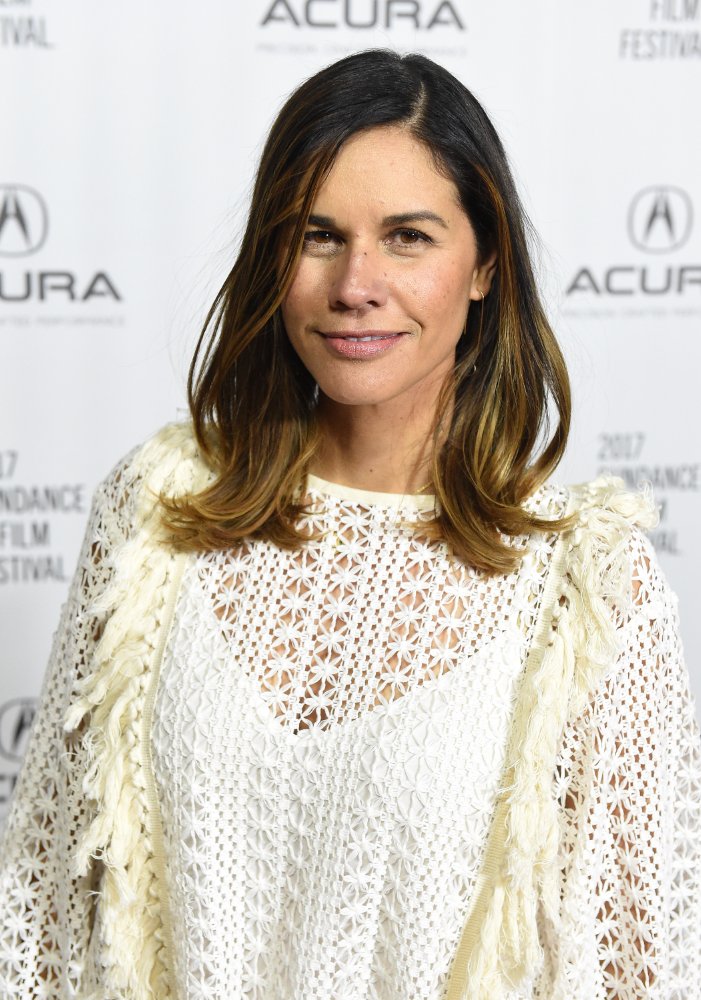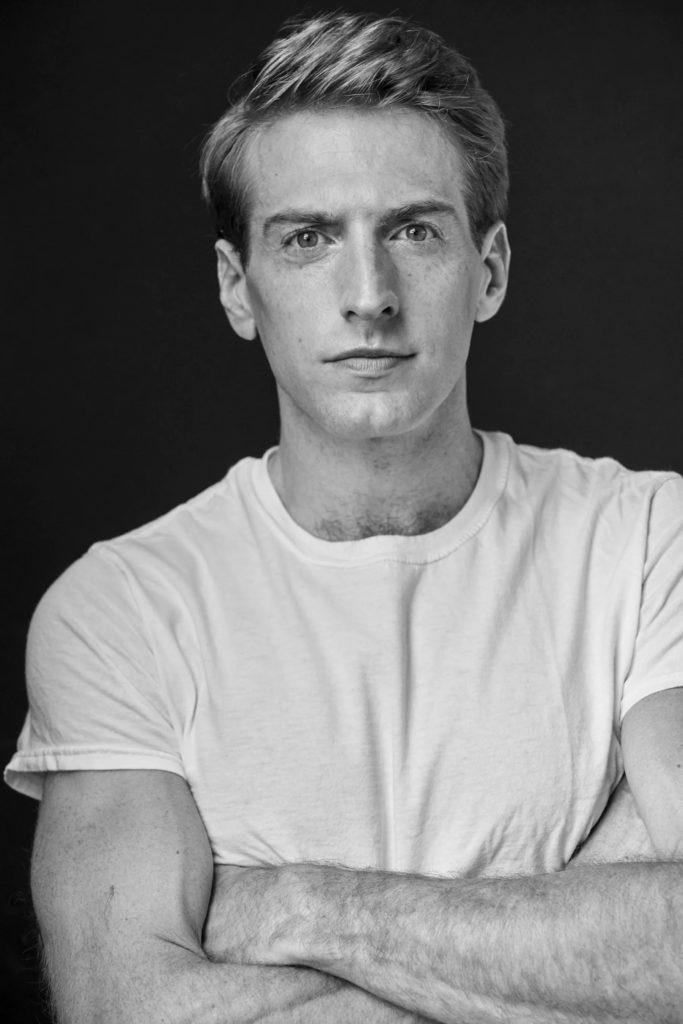The coming-of-age comedy FUNNY PAGES may be from a first-time feature screenwriter/director, though anyone with a fondness for independent film knows that OWEN KLINE is anything but a newbie to cinema. As an actor, Kline made a splash at age 13 as the youngest son of Jeff Daniels and Laura Linney in Noah Baumbach’s 2005 hit The Squid and the Whale. Even younger than that, Owen acted in the award-winning 2001 indies The Anniversary Party and Life as a House. Since coming of age himself, Kline has brought his talents behind the camera, studying illustration and film at Brooklyn’s Pratt Institute. But beyond the formal education of film school, the professional experience of Hollywood sets, and family pedigree (as the son of actors Kevin Kline and Phoebe Cates), it was Kline’s introduction to New York’s experimental film community that really solidified his filmmaking bona fides. It was here where teenage Kline met Josh and Benny Safdie, who at the time were making short films that Owen assisted on as actor and crewmember.
The Safdie Brothers connection came in handy when Kline began making his own films in adulthood (starting with the 2013 short Fowl Play). As he worked on his feature screenplay for Funny Pages — about an aspiring cartoonist and the misanthrope he hopes will become his mentor — Kline sought feedback from the Safdies and their production company Elara Pictures. Eventually, the company signed on to produce the film, which stars Daniel Zolghadri as Robert, a New Jersey teen who drops out of high school to become an illustrator; and Matthew Maher as Wallace, a one-time comics industry pro who becomes an unwilling teacher. Kline rounds out his cast with an array of talented New York character actors including Josh Pais, Maria Dizzia, Marcia DeBonis, Miles Emanuel, Michael Townsend Wright, Ron Rifkin, and Louise Lasser. Funny Pages premiered as part of the 2022 Cannes Directors’ Fortnight and will be released by A24 in select theaters on August 26.
Owen Kline was kind enough to talk to us about the inspirations behind his feature debut as writer, director, and editor.
——
COLIN McCORMACK: There might be an assumption that since you were acting at a young age, acting and filmmaking would be your main passion. But you wanted to be a cartoonist first?
OWEN KLINE: Yeah. I was kind of like the idiotic class clown. I always liked comedy and was the kid in the back of the class drawing since day one. I always liked funny stuff and humor comics and comics in the newspaper. That was the first thing I wanted to do. In particular, more than comics was cartooning, period. Exaggerating. Looking at people and studying them and caricaturing. That thing in the movie is very real for certain cartoonists where people get excited that you can draw and it’s, “Oh, draw this person!” “Draw that person!” That was definitely an early way to connect with kids, but also adults. That’s how [Robert] does it and gets a job, so that’s in [the film] in a way.
CM: As you got older, did you discover the edgier, more underground comics outside of the Blondie or Garfield in the newspaper?
OK: Yeah. Those things are so bright and colorful and exciting. And superhero comics, some of those images stuck in my head, sure. There’s a period where I wanted to get into more sophisticated comics and what’s available is superhero comics. But it wasn’t a style I was interested in drawing in, it wasn’t expressive to me. At the time, you’re just trying to get into it. There are great voices in that field, but it’s few and far between. It’s mostly a mill and continues to be a mill across film and comics [laughs]. Finding the undergrounds and [Robert] Crumb at my local comic shop, more so than the offensive aspects of that – although that was exciting too – it was just singular voices. No different than the Andrew Sarris auteurism rule, but even more so because it’s one hand that’s creating all this and reaching out to a reader.
CM: Were you around the same age when you were branching out with comics that you were being drawn to different types of films as well?
OK: Independent film, yeah. I was working at Anthology [Film Archives] under the archivist and discovering the Kuchars and mid-century personal 16mm filmmaking. Jack Smith and Marie Menken and Harry Smith and Jonas Mekas and Adolfas Mekas and [Kenneth] Anger, all of that stuff. The Cinema of Transgression and Nick Zedd, renting that stuff at Kim’s and realizing there’s a lot of overlap [with] underground comics. Even George Kuchar, who was a cartoonist as well and was published in Arcade alongside Crumb and all these guys, those individual voices were so strong. To see it come through a pen and see it’s the same voice as the one making those insane movies was really powerful. It gave me an exciting early formative understanding of the artist and his fingerprint. And that you can be cross-disciplinary in underground art in a way that you can’t in commercial art. That’s what I’ve learned. Not that that’s me, but someone like George Kuchar was able to achieve a certain auteurism across two mediums.
CM: It’s interesting to me that you have professional experience at a young age and you end up having a formal education in the film school side. But then with Kim’s Video, the repertory theaters you could go to, working at the Archives, was that its own filmmaking education that was just as important?
OK: Oh yeah. I worked in retail starting in high school, all through college and my early twenties in video and record stores. I worked at a library, I worked as a video editor for some of these places. My life in New York has sort of been a bombardment of media in a way, in all these different areas. But then when I was 15 or 16 I started working with the Safdies. They had moved to New York, Josh had graduated B.U. He liked my drawings, I liked his movies. I operated boom and performed for them. I animated the trailer for their first feature, Daddy Longlegs; they did an animated trailer for IFC. It was still in that mid-aughts DIY era. I was in a music scene playing in an obnoxious novelty band with a Casio and making fun of other bands, putting out prank call CDs, doing all this stuff that I wanted to do. I wasn’t aspiring to be anything, I was just making. With Josh and Benny in that era, teenagers and adults mixed in various DIY scenes. Mumblecore was going on too, but we were a little bit disconnected from that. I was more interested in the New York chapter of what was going on, with Josh and Benny and Ronnie [Bronstein, also a Funny Pages producer]. Discovering Frownland was huge for me. There was personal cinema and personal stuff being made all around me.
Then I was going to this comic store [Rocket Ship] at the same age. I was 14, 15, 16, 17, spending a lot of time at this comic store that supported local artists. And local artists would hang around at these parties and Art Spiegelman would show up and would be smoking out in the garden and talking. Some cartoonists you loved that drew for Nickelodeon Magazine when you were a little kid would show up drunk. It was just odd and everything felt independent. All these people and scenes were right there.
I was more cross-disciplinary as a teenager than I am now, I had to sort of focus. I applied to art school for cartooning and then realized I wanted to be a filmmaker and collaborator; I didn’t want to be chained to a desk. Then it was trying to figure out how to apply cartooning to film. Looking at things by Frank Tashlin and Joe Dante and Mike Judge and seeing how they did it. The film school I went to was a pretty unconventional film school because it was an art school, it was Pratt. [Film] was the smallest program, we were in the basement with the photo kids. But Kodak would provide them with a ton of film and we had the Eclair NPR camera and a couple of craggy old pieces [of equipment] and I learned how to edit and synch on the Steenbeck. And I did a bunch of movies that way. At the same time, I was collecting Super 16mm reels and raiding Anthology’s basement for educational films and painting on them. I was just very overactive in all these different ways. I loved 16 as sort of a disposable medium. I have so many weird prints of old cartoons and things people were throwing away at flea markets. 16 as a medium, period, is very inspiring. I love running it as much as I love rolling it through a camera.
CM: As you were working on the [Funny Pages] script and getting feedback from the Safdies and other people in your orbit, how did you know it was finally time to move forward and it was ready to go into production?
OK: It’s never ready. I ran through about 40 drafts. First draft was 2014, then there were about 40 drafts between 2014 and 2017 when we started shooting. Then there were four years of editing and more writing and finding a new 40 pages. That took a long time. I had a two-hour movie then I sliced it in half and decided, This hour is good. But maybe the character wouldn’t do this-and-this. It’s more interesting if this-and-this happens. You want to be true to [characters], then sometimes you put it on the screen and realize you weren’t true to them. And you have to keep toying with them and being gracious with them and investigating the footage and finding more that’s there than you intended and teasing that out of it, as opposed to necessarily trying to execute something that you think is perfect. I’ve never approached anything that way.
CM: How many shooting days were stretched out over that long period?
OK: Oh, God. In total? We had probably 30 initially and then 10 or so days where we had to execute about 45 pages of material, which is incredibly difficult, as you can imagine. Thankfully, we had no children or animals. There were a lot of old people [laughs]. There were a lot of non-SAG actors. There was a lot to figure it out, putting it all together in that regard.

CM: How did you end up finding Daniel? I’ve heard you talk about being cast by Noah Baumbach [in The Squid and the Whale] where was looking for someone who wasn’t the polished, overly-rehearsed child actor. Was there something similar to that, where you didn’t want the 27-year-old from The CW playing a teenager?
OK: Definitely a lot of guys with five-o’clock-shadows read for this part. Yeah, most representations of high school teenagers, it’s weird when you’re watching one and they look like convicts. Even Fast Times, the scalper who has the Blue Oyster Cult tickets? He looks like a 40-year-old guy who’s been to prison twice, he does not look like a teenager [laughs]. But some teenagers look like that and it’s terrifying. There are certain kids who are just weathered. But that wasn’t [Robert]. Casting Daniel told the story in a way. He was on some level a very fragile kid, but he’s trying to harden himself and weather this storm that he’s creating. He just embodied that in a way, even in his tape that he sent in. There was a level of self-destruction that he was able to capture. Most people that came in copped an attitude when they were reading this character. The attitude with [Daniel], he didn’t have to push that. He didn’t have to play this character as a dick. There was this sort of lashing inward as much as he’s lashing outward. He tapped into the character’s insecurity, which I think gives it pathos. It keeps him from being your regular Bart Simpson.
CM: Did the character of Wallace change much once Matthew Maher was cast from how it was initially written?
OK: It’s funny, I wrote it to be a very particular kind of neurotic Jewish guy, and Matt is a goy from Massachusetts. The character I wrote was very particular and neurotic and prissy. And the prissiness and pickiness and entitlement of the character, whether he’s rejecting the defense attorney the state has provided him or lying in a teenager’s bed on Christmas and dismissing his artwork, that just felt funny. It felt like a funny contrast to who this guy was and Matt kind of fit like a glove. I’d written all these tape loops and he really thought about the logic behind them and really considered it. Because there has to be an internal logic if you’re going to write tape loops, you can’t just write crazy people as crazy. There has to be some sort of restraint, and that restraint is logic. You have to apply logic to, Why would this guy ask this kid to go inside this pharmacy and do his bidding? It becomes beyond a psychopathic endeavor or vanity project for this guy. All that stuff felt very funny to me, how this guy was exorcising his petty grievances. It felt like this large shadow for Robert of what could come. Putting aside the fact that this guy is a broken-down cartoonist, what could come of embracing a certain bitterness? I feel very versed in being frustrated with my own work when working in retail. I worked at a lot of snotty media retail jobs, you know? Those personalities were around me and formed me. It’s like the Video Store Guy/Record Store Guy/Comic Book Store Guy disease.
CM: Obviously we like casting stories. But you had a unique opportunity to not only cast this great ensemble of wonderful actors, but also cast artists to do the drawings that different characters do in the film. What’s a casting process for a cartoonist like? Were you putting out a call for submissions, or did you already have people in mind?
OK: No, I knew the artists that I wanted to use, and some of them I knew personally. My best friend Charlie Judkins, who I met because he wore a pin in that store Rocket Ship that said “Ask me about AfroBot” and I asked him about [his comic] AfroBot. He wasn’t expecting me to because no one had ever asked him about it. It’s what Miles is wearing in the scene and he’s showing these comics. The fact that those comics weren’t created for the movie added a certain layer of authenticity to them because they were real. It’s anthropological for me and won’t have the same resonance for other people, but it has some resonance because it’s not an actual prop in a movie, it’s a thing that was actually a kid’s ambition. There’s a level of reality to that.
For creating [Robert’s art], I knew Johnny Ryan and wrote letters to him when he had his comic Angry Youth Comix in the aughts, which was republished recently. He was someone that the Safdies knew as well and he just cranks out comics and his stuff is pretty sick and juvenile and hilarious, so I just let him go. He could draw down a little bit, could draw to a 16-year-old kid’s level a bit more. And I inked all those drawings, actually. I’m a lefty and the character was a lefty, so I did all the inking for those. We’d have Johnny draw them in stages, he would pencil it first, and then we’d scan it a little bit and a little bit more so I had pieces to connect between close-ups and the other shots.
Then Rick Altergott did all of the teacher, Mr. Katano’s, art. A lot of that was pages of his comic book Doofus, which is a FanaGraphics title from around the era of Peter Bagge’s Hate and Dan Clowes’ Eightball. He’d gone to Pratt, where I’d gone, with Dan Clowes in the ‘80s and they inspired each other’s stuff. He has a really esoteric, fantastic drawing style in the vein of Wally Wood inspired by this really lavish, otherworldly, bygone era of American comics. Seeing that that was the teacher’s work I think totally explained Robert’s. Originally, I had Altergott doing Robert’s work but it didn’t seem like it was actually coming from a 16-year-old kid. So I said, “Okay, you’ve already done all these crass comics that I suggested for the character. We can just use these for the teacher and it’s even better.” I think seeing a drawing that a character creates can say as much about the character as a line of dialogue.
CM: My time is just about up so to wrap things up, do you know what’s next for you?
OK: I have another comedy.
CM: Writing, directing, and editing once again?
OK: If they let me!
CM: One last thing- that basement set, man. It’s so good but so suffocating.
OK: It was not real! It’s not real. People think it’s real, which is amazing. People go, “Where did you find that basement?!” It was just a basement and we had to basically perform as a team to make it seem like it was actually livable. That was a hard test. I found this disgusting place and said, “Make this seem lived-in by two old men.” The details of that and installing every object that went in there with consideration was a hysterical process, but that was the art department. Madeline Sadowski and Audrey Turner and Kaili Corcoran and a bunch of amazing people put that thing together. That was the first stuff we shot in the movie and it kind of set the tone for the rest of the movie in a strange way in terms of how surreal and demented this thing could be. I’m so glad we started there.
__
A big thanks to Owen talking to us about FUNNY PAGES. Learn more about the film at the A24 website.
This interview has been edited for clarity.
If you’re an independent filmmaker or know of an independent film-related topic we should write about, email blogadmin@sagindie.org for consideration.




